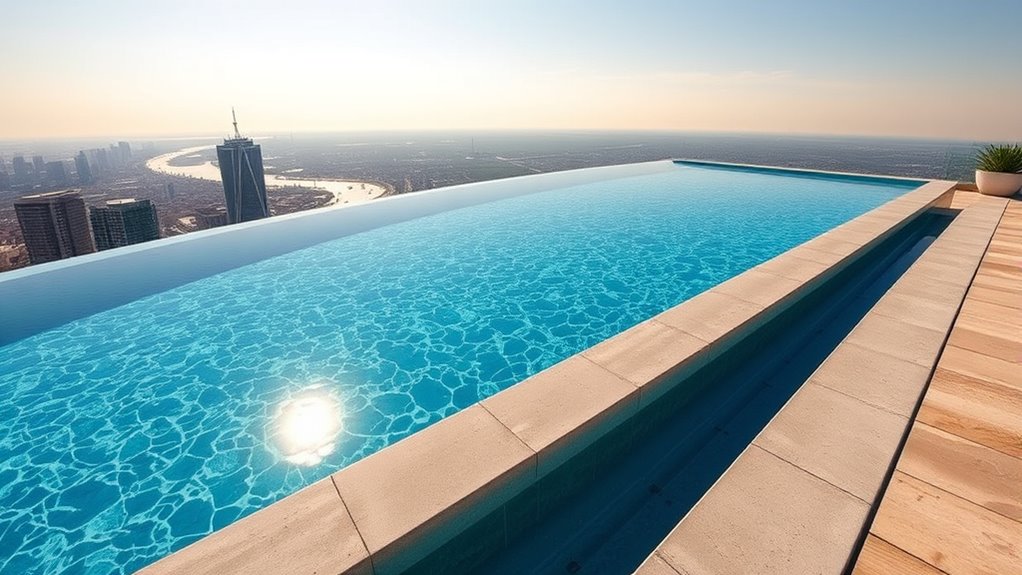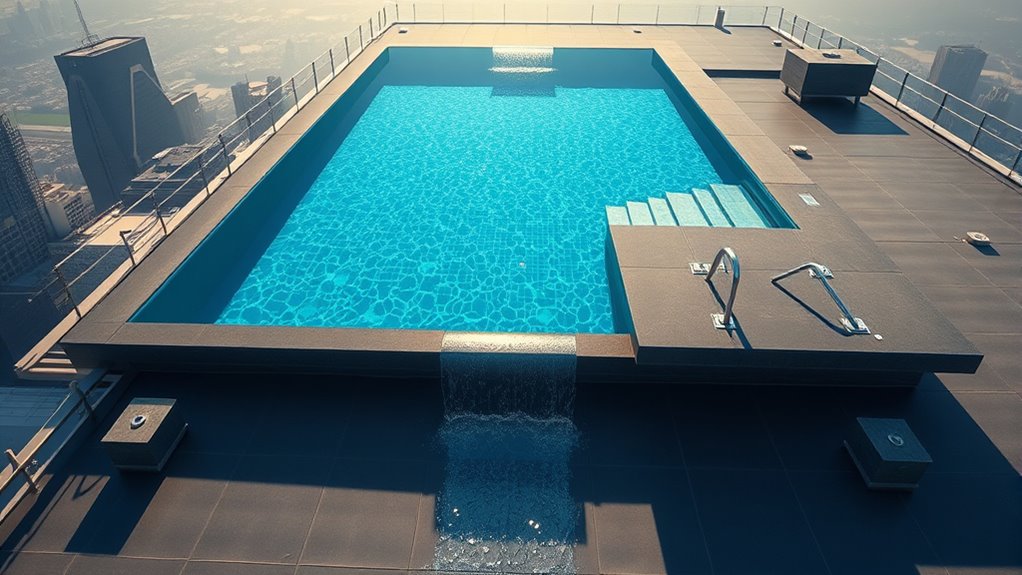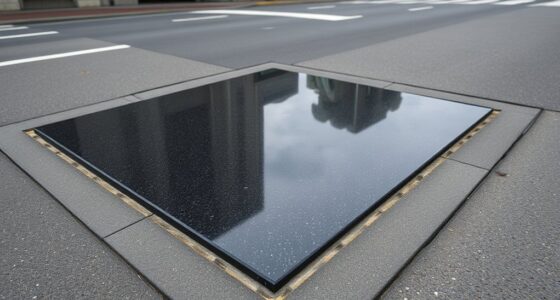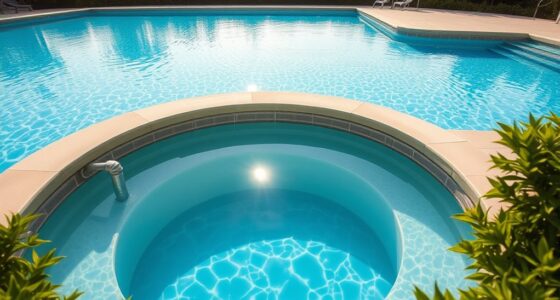When planning a rooftop infinity pool, you must carefully evaluate the structural loads, including water weight, occupants, and dynamic factors like wind or movement, to guarantee your support system can handle the stress. Proper load distribution and reinforcement with materials like steel or high-performance concrete are essential for safety. Waterproof detailing with seamless membranes and effective drainage prevent leaks and water damage. Continuing further will give you detailed tips to ensure durability and performance.
Key Takeaways
- Assess rooftop support capacity through load distribution analysis to ensure it can handle the combined dead and live loads of the infinity pool.
- Incorporate reinforcement such as steel supports or thickened slabs to strengthen structural elements against dynamic water and occupant loads.
- Use durable waterproofing membranes like polyurethane or PVC sheet systems to create a seamless barrier protecting the structure from water infiltration.
- Design effective drainage with proper slope and strategic placement to prevent water pooling and facilitate maintenance around the infinity edge.
- Implement expansion joints and flexible sealants to accommodate thermal movement, preventing cracks and ensuring waterproof integrity over time.
Understanding the Structural Demands of Rooftop Infinity Pools

Since rooftop infinity pools involve significant water weight and dynamic loads, understanding their structural demands is vital. The weight of the water, combined with the pool’s volume, creates substantial static loads that your building must support. Additionally, dynamic factors like movement, occupancy, and water displacement can increase stress on the structure. You need to guarantee the existing building foundation and framework can handle these loads without compromising safety. Proper structural design accounts for load distribution, reinforcement, and material strength to withstand both dead loads (the weight of the pool itself) and live loads (people, maintenance). Incorporating appropriate load calculations ensures the structure can sustain these demands over time. Ignoring these demands risks structural failure, so thorough analysis and planning are essential before proceeding with installation. This understanding helps create a safe, durable rooftop infinity pool.
Assessing Building Support and Load-Bearing Capacity

Before installing a rooftop infinity pool, you need to evaluate if your building can handle the additional weight. Consider the building’s current support system and whether reinforcement is necessary to distribute the load evenly. Conducting a load distribution analysis helps guarantee safety and stability for your pool project. Additionally, consulting with structural engineers can provide insights into building support requirements and ensure compliance with safety standards.
Structural Reinforcement Needs
Evaluating the building’s support and load-bearing capacity is a essential first step in installing a rooftop infinity pool. Once you determine the existing structural limits, you can identify if reinforcement is necessary. You’ll need to assess the strength of beams, columns, and the slab to handle the additional weight of water, equipment, and live loads. If the current structure isn’t sufficient, you’ll likely require reinforcement, such as adding steel supports, thickening slabs, or installing new load-bearing elements. Consulting a structural engineer is critical to develop an effective reinforcement plan that ensures safety and stability. Proper reinforcement not only prevents structural failure but also extends the lifespan of your rooftop installation, giving you peace of mind with your luxurious new feature. Additionally, understanding the structural loads involved helps in selecting appropriate materials and design strategies for a durable and safe rooftop pool.
Load Distribution Analysis
Evaluating the building’s support and load-bearing capacity involves a detailed load distribution analysis to guarantee your rooftop can handle the added weight of an infinity pool. You’ll need to assess existing structural elements, including beams, columns, and slabs, to determine how loads are transferred and distributed. This process identifies potential weak points and ensures the structure can sustain the pool’s weight plus water, equipment, and occupants. You may require structural modifications or reinforcements to improve load capacity. It’s crucial to work with structural engineers to perform calculations, load testing, and modeling. Proper load distribution analysis helps prevent structural failure, ensuring safety and longevity of your rooftop infinity pool. Additionally, understanding building support systems is essential for effective load management. This step is critical before proceeding with waterproofing and finishing details.
Load Distribution and Dynamic Effects on Roof Structures

Understanding how load distribution and dynamic effects impact roof structures is essential when designing rooftop infinity pools. You need to contemplate how static loads, like the weight of water and equipment, spread across the roof. Dynamic effects, such as wind, thermal expansion, and occupancy movement, can cause additional stresses. To manage these factors effectively: 1. Assess load paths to ensure forces transfer properly to the building’s core. 2. Incorporate allowances for dynamic loads, accounting for wind gusts and seismic activity. 3. Use flexible connections and expansion joints to accommodate movement and prevent stress concentrations. Additionally, advancements in structural engineering and building codes contribute to safer and more efficient rooftop pool designs.
Material Selection for Structural Reinforcement

Selecting the right materials for structural reinforcement is essential to guarantee your rooftop infinity pool remains safe and durable under various loads and environmental conditions. You need materials that offer high strength, good ductility, and resistance to corrosion, especially since exposure to moisture and weather is inevitable. Reinforcing steel, such as epoxy-coated rebar, provides excellent tensile capacity and corrosion protection, making it ideal for rooftop applications. Additionally, fiber-reinforced polymers (FRP) can be a lightweight alternative with high durability. For concrete, opt for high-performance mixes that resist cracking and shrinkage. Ensuring compatibility between materials is vital to prevent issues like delamination or corrosion. Material compatibility is a crucial factor to consider when selecting reinforcement options. By carefully choosing these materials, you enhance the structural integrity and longevity of your rooftop infinity pool, safeguarding your investment and safety.
Designing Structural Frameworks for Stability and Safety

Designing structural frameworks for stability and safety requires careful planning to guarantee your rooftop infinity pool can withstand various loads and environmental forces. First, assess the dead loads, including the weight of the pool, water, and construction materials. Next, consider live loads like occupancy, maintenance, and potential snow or wind pressure. Finally, account for dynamic forces such as seismic activity or heavy gusts. To ensure robustness, you should: 1. Use reinforced concrete or steel framing designed for high load capacity. 2. Incorporate bracing and shear walls to resist lateral forces. 3. Conduct thorough structural analysis and load testing before installation. Additionally, understanding sound vibrations can inform design choices that mitigate structural stress during environmental disturbances. These steps help create a resilient framework that keeps your pool safe and stable while withstanding environmental challenges.
Waterproofing: Key Principles and Material Options

Effective waterproofing is essential to prevent leaks and protect your rooftop infinity pool from water damage. You need a reliable waterproofing system that bonds well to the substrate and resists water penetration over time. Key principles include ensuring a continuous, seamless barrier without gaps or weak spots, which requires proper surface preparation and adherence. Material options vary; you might consider liquid-applied membranes like polyurethane or elastomeric coatings for flexibility, or sheet membranes such as PVC or TPO for durability and ease of installation. Additionally, liquid membranes often offer seamless coverage, reducing potential leak points. Select materials that are UV resistant, weatherproof, and compatible with your pool’s structure. Proper waterproofing not only preserves your pool’s integrity but also minimizes maintenance costs and extends its lifespan. Regular assessment and appropriate space management strategies can also help identify potential vulnerabilities early.
Detailing for Effective Waterproof Barriers and Drainage

Choosing the right membrane material is vital for a durable waterproof barrier, so consider options that resist UV and chemical exposure. Designing an effective drainage system guarantees water flows away quickly, preventing pooling and damage. Pay attention to joint and sealant strategies to create seamless, leak-proof connections that withstand rooftop conditions. Implementing analytical cookies during design phases can help monitor and optimize drainage efficiency and waterproofing performance.
Membrane Material Selection
Selecting the right membrane material is essential for guaranteeing your rooftop infinity pool remains watertight and properly drained. The membrane acts as the primary waterproof barrier, so choosing the appropriate type impacts durability and performance. Consider these key options:
- PVC Membranes: Flexible, easy to install, and resistant to chemicals, making them suitable for rooftop pools.
- EPDM Rubber: Known for its excellent weather resistance and flexibility, ideal for long-term waterproofing.
- Polyurethane Coatings: Provide seamless coverage with high elasticity, perfect for complex geometries and detailed finishes.
Your choice depends on factors like exposure to sunlight, movement, and compatibility with other materials. Selecting the right membrane assures longevity and effective waterproofing, preventing leaks and structural damage.
Drainage System Design
A well-designed drainage system is essential to guarantee your rooftop infinity pool remains watertight and functions properly over time. You need to plan for effective slope gradients—usually 1-2%—to ensure water flows smoothly toward the drains without pooling. Position the drains strategically around the perimeter and at low points to prevent standing water, which can cause leaks or structural issues. Use high-quality, corrosion-resistant materials for the drainage components to withstand exposure to water and weather. Incorporate catch basins or skimmers if necessary, and ensure they’re easily accessible for maintenance. Properly sealed connections between the drainage system and waterproof membranes are critical to avoid leaks. Regular inspection and cleaning of the drains will keep your pool’s waterproof integrity intact and prevent costly repairs. Employing advanced waterproofing techniques can further enhance the durability of your waterproof barriers and drainage setup.
Joint and Sealant Strategies
To guarantee your rooftop infinity pool remains watertight, you must pay close attention to joint and sealant strategies, which create critical barriers against water infiltration. Proper detailing ensures water stays within the pool and doesn’t seep into the structure. Consider these key points:
- Select flexible, waterproof sealants designed for pool environments to accommodate movement and temperature changes.
- Use continuous, well-placed joints with proper backing materials to prevent gaps and ensure sealant effectiveness.
- Regularly inspect and maintain joints and sealants to address wear, cracking, or deterioration before leaks develop.
Managing Thermal Expansion and Contraction

When dealing with rooftop infinity pools, managing thermal expansion and contraction is vital to guarantee structural integrity and safety. Temperature fluctuations cause materials to expand and contract, which can lead to cracks, leaks, or even structural failure if unaddressed. To mitigate this, you should incorporate expansion joints at strategic points, allowing movement without stressing the structure. Selecting materials with compatible thermal expansion properties helps prevent warping or delamination. Additionally, consider installing flexible sealants around edges and joints to accommodate movement while maintaining waterproof integrity. Proper insulation also plays a role by reducing temperature extremes. By proactively managing these thermal movements, you assure your rooftop infinity pool remains safe, durable, and visually stunning over time, regardless of seasonal or daily temperature changes.
Maintenance and Inspection Strategies for Longevity

Regular maintenance and inspections are key to ensuring your rooftop infinity pool remains safe and visually stunning over time. To keep everything in top shape, focus on these strategies:
- Schedule regular visual inspections for cracks, leaks, or signs of wear on the waterproofing and structural elements.
- Test the water chemistry frequently to prevent corrosion or buildup that could damage surfaces.
- Clean filters and drainage systems weekly to avoid blockages and maintain proper circulation.
Frequently Asked Questions
How Do Wind Loads Affect Rooftop Infinity Pool Structures?
Wind loads can considerably impact your rooftop infinity pool structure by exerting lateral pressure that may cause movement or stress. You need to guarantee proper structural reinforcement, like bracing and anchoring, to resist these forces. Additionally, designing for wind uplift helps prevent damage. Regular inspections and maintenance are essential to address any potential issues early, ensuring your pool remains safe and stable despite high wind conditions.
What Are the Best Practices for Integrating Waterproofing With HVAC Systems?
You should verify waterproofing membranes are properly sealed around HVAC penetrations and equipment. Use flexible, compatible sealants to accommodate movement and prevent leaks. Install drainage layers to direct water away from HVAC components, and incorporate vapor barriers to control moisture. Regularly inspect and maintain seals, and coordinate with HVAC contractors during design to ensure waterproofing details integrate seamlessly, reducing the risk of water ingress and damage.
How Does Seismic Activity Influence Rooftop Infinity Pool Design?
Seismic activity influences your rooftop infinity pool design by demanding enhanced structural resilience, flexible joints, and seismic-resistant materials. You must reinforce the pool’s structure to withstand ground movements, incorporate base isolators to absorb shocks, and select waterproofing systems that accommodate movement without damage. By prioritizing these elements, you guarantee safety, durability, and water integrity, preventing costly repairs and potential hazards during an earthquake.
What Safety Features Are Essential for Rooftop Infinity Pool Structures?
You should incorporate safety features like sturdy railings, non-slip surfaces, and secure access points to prevent falls and accidents. Guarantee the pool’s structural integrity with adequate load-bearing capacity and proper waterproofing to avoid leaks. Install safety alarms, fencing, and lighting for enhanced security, especially at night. Regular maintenance checks and adherence to local building codes are essential to keep the structure safe for users and prevent potential hazards.
How Can Waterproofing Materials Be Environmentally Sustainable?
An ounce of prevention is worth a pound of cure, so choosing eco-friendly waterproofing materials is essential. You can opt for recycled or biodegradable materials like liquid membranes made from plant-based compounds or those with low VOC emissions. These options reduce environmental impact while ensuring waterproof integrity. By making sustainable choices, you protect both your investment and the planet, proving that doing good and doing well can go hand in hand.
Conclusion
To keep your rooftop infinity pool in top shape, you need to stay ahead of potential issues. Regular inspections and proper waterproofing are your best bets to avoid costly repairs. Remember, a stitch in time saves nine—addressing small problems early prevents bigger headaches down the road. With the right structural support and maintenance, your stunning pool will be the crown jewel of your building for years to come.










